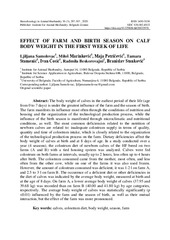Приказ основних података о документу
Effect of farm and birth season on calf body weight in the first week of life
| dc.creator | Samolovac, Ljiljana | |
| dc.creator | Marinković, Miloš | |
| dc.creator | Petričević, Maja | |
| dc.creator | Stamenić, Tamara | |
| dc.creator | Ćosić, Ivan | |
| dc.creator | Beskorovajni, Radmila | |
| dc.creator | Stanković, Branislav | |
| dc.date.accessioned | 2020-12-29T08:22:17Z | |
| dc.date.available | 2020-12-29T08:22:17Z | |
| dc.date.issued | 2020 | |
| dc.identifier.issn | 1450-9156 | |
| dc.identifier.uri | http://r.istocar.bg.ac.rs/handle/123456789/720 | |
| dc.description.abstract | The body weight of calves in the earliest period of their life (age from 0 to 7 days) is under the greatest influence of the farm and the season of birth. The farm manifests its influence most often through the conditions of nutrition and housing and the organization of the technological production process, while the influence of the birth season is manifested through microclimatic and nutritional conditions, as well. The most common deficiencies related to the nutrition of newborn calves are related to: inadequate colostrum supply in terms of quality, quantity and time of colostrum intake, which is closely related to the organization of the technological production process on the farm. Dietary deficiencies affect the body weight of calves at birth and at 8 days of age. In a study conducted over a year (4 seasons), the colostrum diet of newborn calves of the HF breed on two farms (A and B) with a tied housing system was analyzed. Calves were fed colostrum on both farms at intervals, usually up to 2 hours, less often up to 4 hours after birth. The colostrum consumed came from the mother, most often, and less often from the other cow, while on one of the farms it was also used frozen. However, the amount of colostrum consumed was deficient, it was 1-2 l on farm A, and 2.5 to 3 l on farm B. The occurence of a deficient diet or other deficiencies in the diet of calves was indicated by the average body weight, measured at birth and at the age of 8 days. On farm A, a lower average body weight of calves (37.95 and 39.68 kg) was recorded than on farm B (40.00 and 41.80 kg) by age categories, respectively. The average body weight of calves was statistically significantly (p <0.01) influenced by the farm and the season of birth, as well as their mutual interaction, but the effect of the farm was more pronounced. | sr |
| dc.language.iso | en | sr |
| dc.publisher | Institute for Animal Husbandry, Belgrade-Zemun | sr |
| dc.relation | info:eu-repo/grantAgreement/MESTD/inst-2020/200022/RS// | sr |
| dc.rights | openAccess | sr |
| dc.rights.uri | https://creativecommons.org/licenses/by/4.0/ | |
| dc.source | Biotechnology in animal husbandry | sr |
| dc.subject | calves | sr |
| dc.subject | colostrum diet | sr |
| dc.subject | body weight | sr |
| dc.subject | season | sr |
| dc.subject | farm | sr |
| dc.title | Effect of farm and birth season on calf body weight in the first week of life | sr |
| dc.type | article | sr |
| dc.rights.license | BY | sr |
| dcterms.abstract | Станковић, Бранислав; Бескоровајни, Радмила; Ћосић, Иван; Самоловац, Љиљана; Маринковић, Милош; Стаменић, Тамара; Петричевић, Маја; | |
| dc.citation.volume | 36 | |
| dc.citation.issue | 3 | |
| dc.citation.spage | 297 | |
| dc.citation.epage | 307 | |
| dc.citation.rank | M24 | |
| dc.identifier.doi | doi.org/10.2298/BAH2003297S | |
| dc.identifier.fulltext | http://r.istocar.bg.ac.rs/bitstream/id/3835/bitstream_3835.pdf | |
| dc.type.version | publishedVersion | sr |


